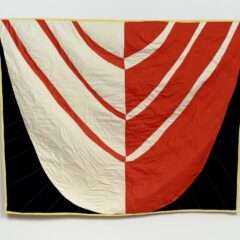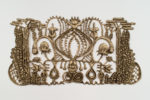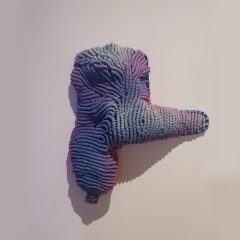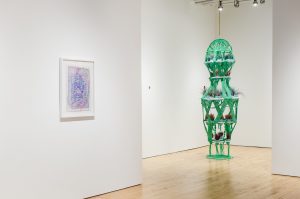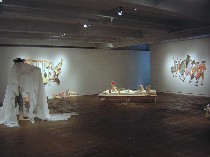 The pure products of Americana go crazy in Isaac Resnikoff’s one-man show “We Run Out of Continent,” at Fleisher/Ollman gallery. Resnikoff’s work is familiar both from a previous showing in the Junto group show at F/O (see post) and from shows at Vox Populi (see posts here and here.) He has outdone himself, here, filling the large space at F/O with a coherent body of wonderful work (left, installation shot of “We Run Out of Continent”).
The pure products of Americana go crazy in Isaac Resnikoff’s one-man show “We Run Out of Continent,” at Fleisher/Ollman gallery. Resnikoff’s work is familiar both from a previous showing in the Junto group show at F/O (see post) and from shows at Vox Populi (see posts here and here.) He has outdone himself, here, filling the large space at F/O with a coherent body of wonderful work (left, installation shot of “We Run Out of Continent”).The show, all of carved wood, like much of Resnikoff’s previous work, draws on the mythology of the American good-life, as understood by the common man. It’s a land of eagles and geodes, of hand made and rough hewn, of banjos and flipflops, buffalos and indian-head pennies, Founding Fathers and federalism, three-legged stools and Yankee thrift, church-goers and idealistic soldiers.
It’s cornpone and Manifest Destiny rolled into one big value system of patriotic fervor. This is my country.
The title of the show, which refers to California, originated with poet Charles Olson and was then borrowed by Joan Didion, who wrote in “Slouching Towards Bethlehem, “The mind is troubled by some buried but ineradicable suspicion that things had better work here, because here, beneath that immense bleached sky, is where we run out of continent.”
Underneath all that wood carving, I hear Resnikoff suggesting that we also run out of wood. There’s a suggestion of poison in the cornpone, of diminishing resources, diminishing space, diminishing values. There’s also the suggestion that because these are not the real objects but reproductions of them, that they capture the falseness of the objects–the myths the objects represent.
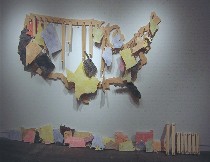 Resnikoff is a guy who likes maps, and he’s got three of them in this show. “The Federalist” is a large, interactive map of the U. S. mainland that is a Brobdingnagian wooden jigsaw puzzle. A Shaker peg and spacer system allows for multiple interpretations of how to assemble the states (right, “The Federalist”).
Resnikoff is a guy who likes maps, and he’s got three of them in this show. “The Federalist” is a large, interactive map of the U. S. mainland that is a Brobdingnagian wooden jigsaw puzzle. A Shaker peg and spacer system allows for multiple interpretations of how to assemble the states (right, “The Federalist”).
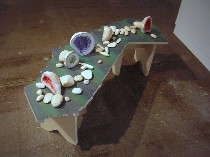
He also has a bench shaped on top like the map of California, on which rest “geodes” and other “rocks” made of wood, evoking the gold-rush values of old and new California as well as the sense of permanent frontier and mountain trails (left, “California Bench” and “Geodes”).
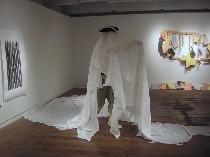
Resnikoff also created a fabric map of a scrim-like material draped around and trailing an 18th Century soldier, “Old Patriot Ghost,” a reminder of how our past haunts our present-day politics. It’s life-size stature and its breadth still take up an inordinate amount of space in our national consciousness. (right, “Old Patriot Ghost”).
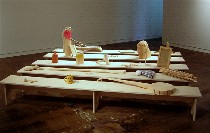 Several rows of benches, on which sit Resnikoff’s wooden carvings of Americana, is called “The Congregation,” an especially appropriate name given the religious fervor of Americans about their country and about their religion. Its placement next to the Shaker-pegged “The Federalist” map and the plainness of the benches seemed especially appropos. The Americana on the benches include a carved smiley face mug with a carved spoon inside. Hilarious. So are the wooden flipflops and the bottle of hooch. Many of the items are more serious–the Indian head, the machinists square, the bar clamp. There’s even a wooden nut and bolt. These small items sold like hotcakes, by the way (left, “The Congregation”).
Several rows of benches, on which sit Resnikoff’s wooden carvings of Americana, is called “The Congregation,” an especially appropriate name given the religious fervor of Americans about their country and about their religion. Its placement next to the Shaker-pegged “The Federalist” map and the plainness of the benches seemed especially appropos. The Americana on the benches include a carved smiley face mug with a carved spoon inside. Hilarious. So are the wooden flipflops and the bottle of hooch. Many of the items are more serious–the Indian head, the machinists square, the bar clamp. There’s even a wooden nut and bolt. These small items sold like hotcakes, by the way (left, “The Congregation”).
All of the things in “Congregation” have been ground through the processor of American values and cooked up in mythologized form into perfect American hamburgers– tasting the way Americans prefer to imagine all things American taste.
 In the land of Indian head nickles, there are also buffalo heads, and Resnikoff’s buffalo head is a beauty, laying large on rolled up red and blue rugs that suggest the American flag, landscape and a sacrificial altar. The interior of this head is hollow, and its method of construction–layered slats of wood then carved on the outside–speaks of the values that Resnikoff is questioning (right,”We Run Out of Continent”).
In the land of Indian head nickles, there are also buffalo heads, and Resnikoff’s buffalo head is a beauty, laying large on rolled up red and blue rugs that suggest the American flag, landscape and a sacrificial altar. The interior of this head is hollow, and its method of construction–layered slats of wood then carved on the outside–speaks of the values that Resnikoff is questioning (right,”We Run Out of Continent”).
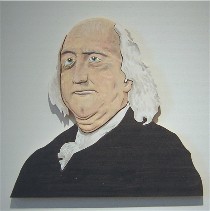
Also in the heads category are three carved heads from relatively shallow planks of wood–Thomas Jefferson, Ben Franklin (left) and George Washington. The shallowness again speaks of what Resnikoff has on his mind about the way we mythologize our cultural icons. Their methodology, but not their content, bring to mind Alex Queral’s phone book portraits.
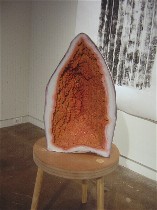
I also love the way Resnikoff names things, placing the objects in some context. For example, a series of nine wood-block prints of fences is called “That Oughta Hold ’em.” The buffalo head is named “We Run Out of Continent,” just like the exhibit. It’s another reminder of diminishing and wasted resources, not to mention suburban sprawl (right, “Geode” and “That Ought to Hold ’em”).
The thing about Resnikoff’s work is the charm of his blunt reproductions. There’s a lovableness and a straighforwardness that knocks me out every time I see a show of his. Fleisher/Ollman, a gallery that specializes in outsider art, has found a young insider artist here whose work seems like a perfect fit.
Also showing at Fleisher/Ollman is a small show by Takatomo Tomita of castings, silkscreen prints, and other works on paper.resnikoff, isaac


